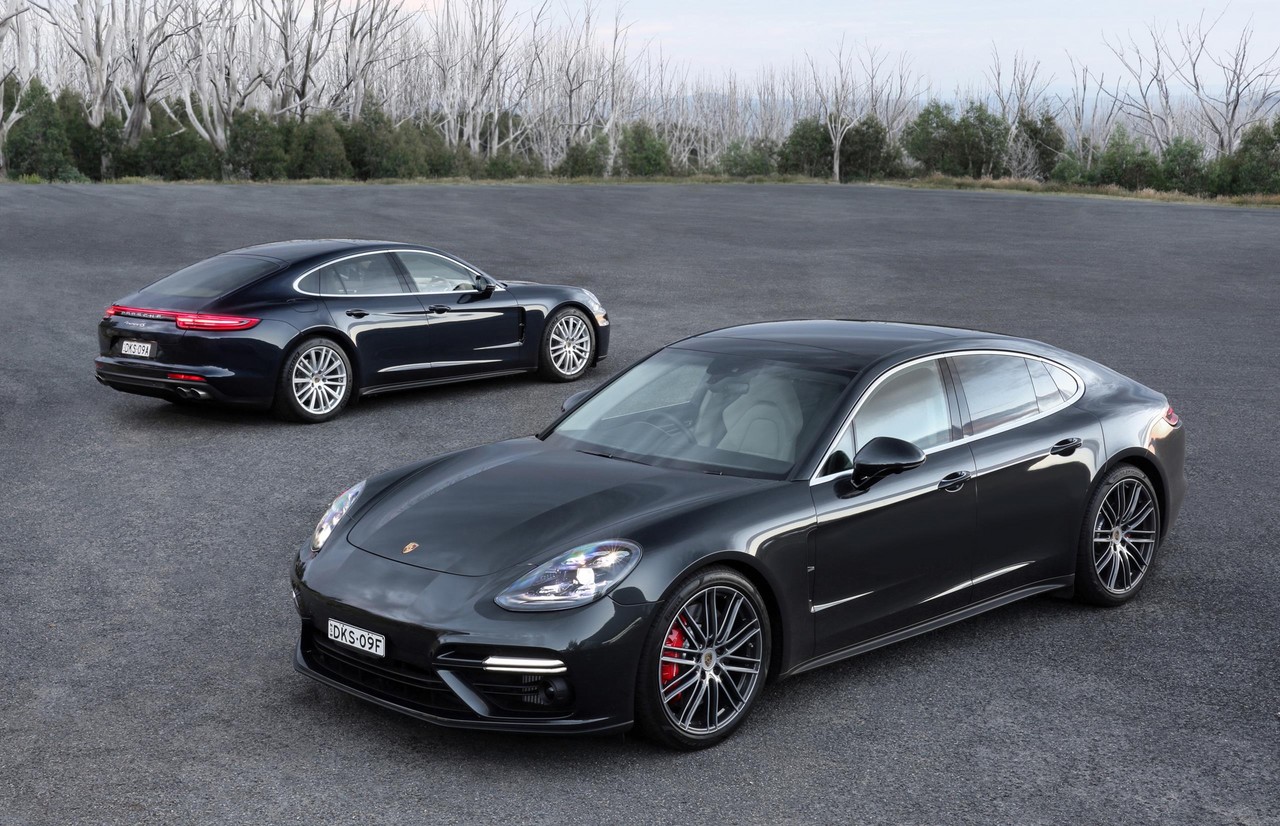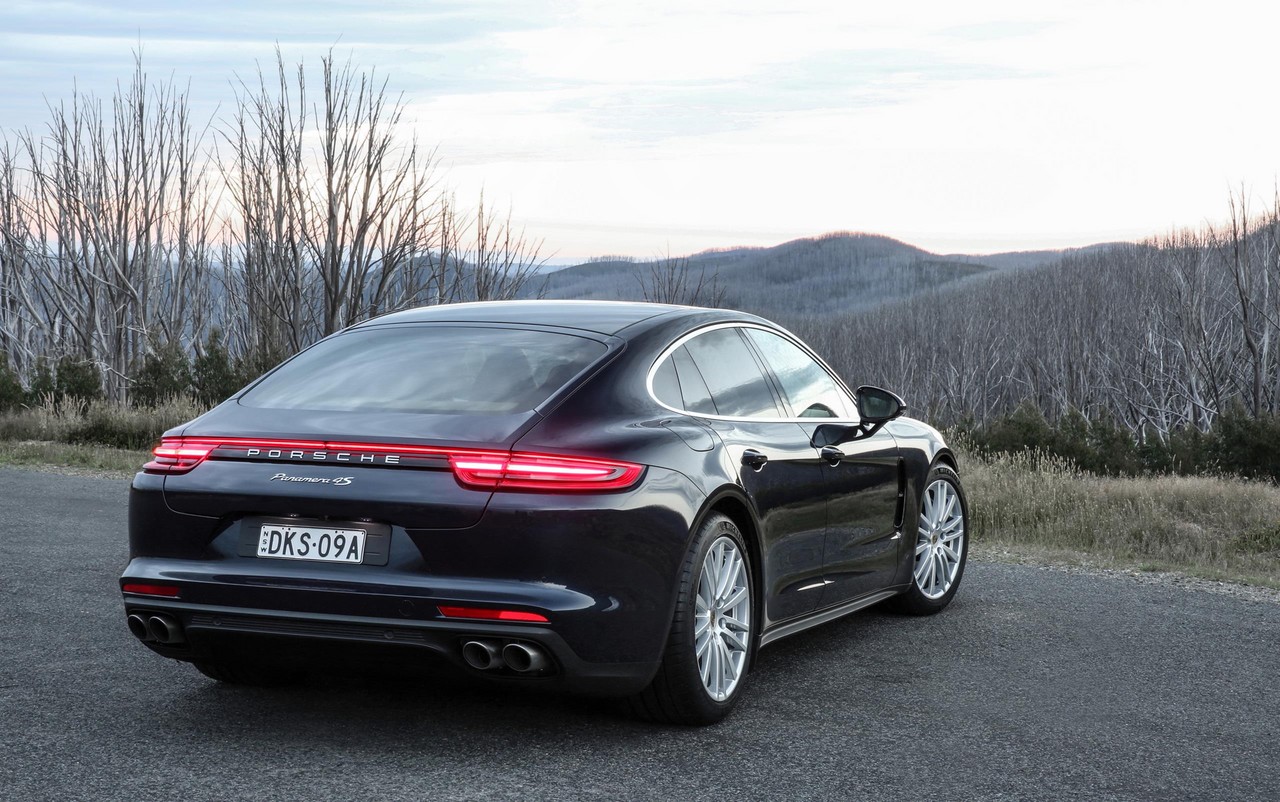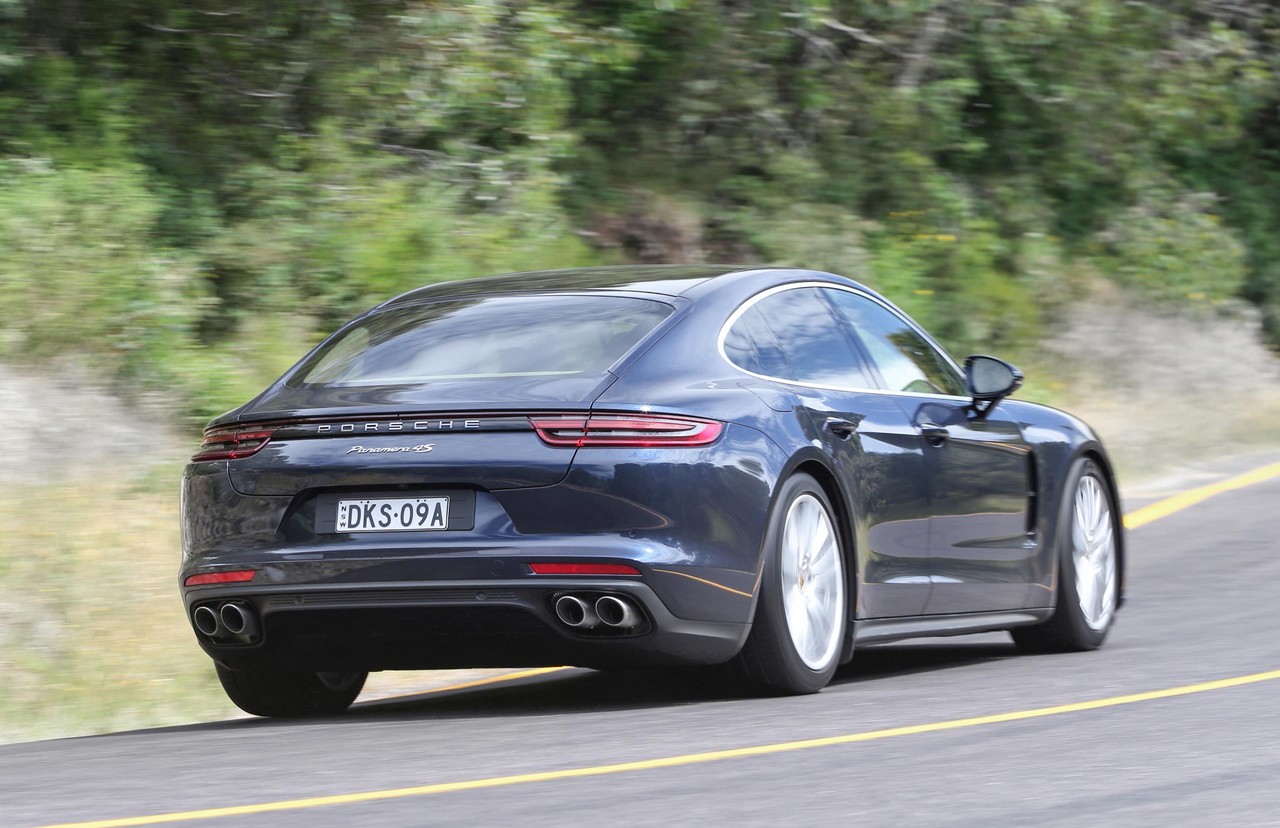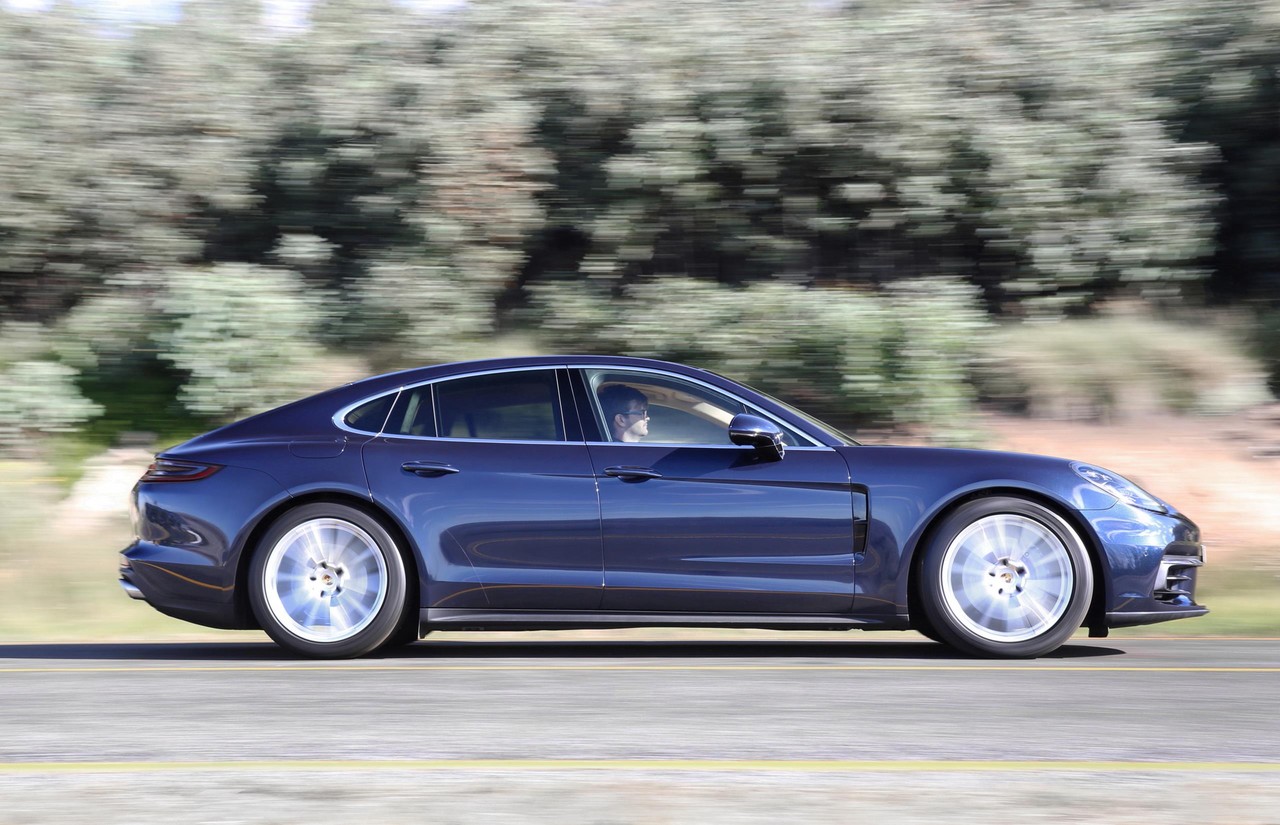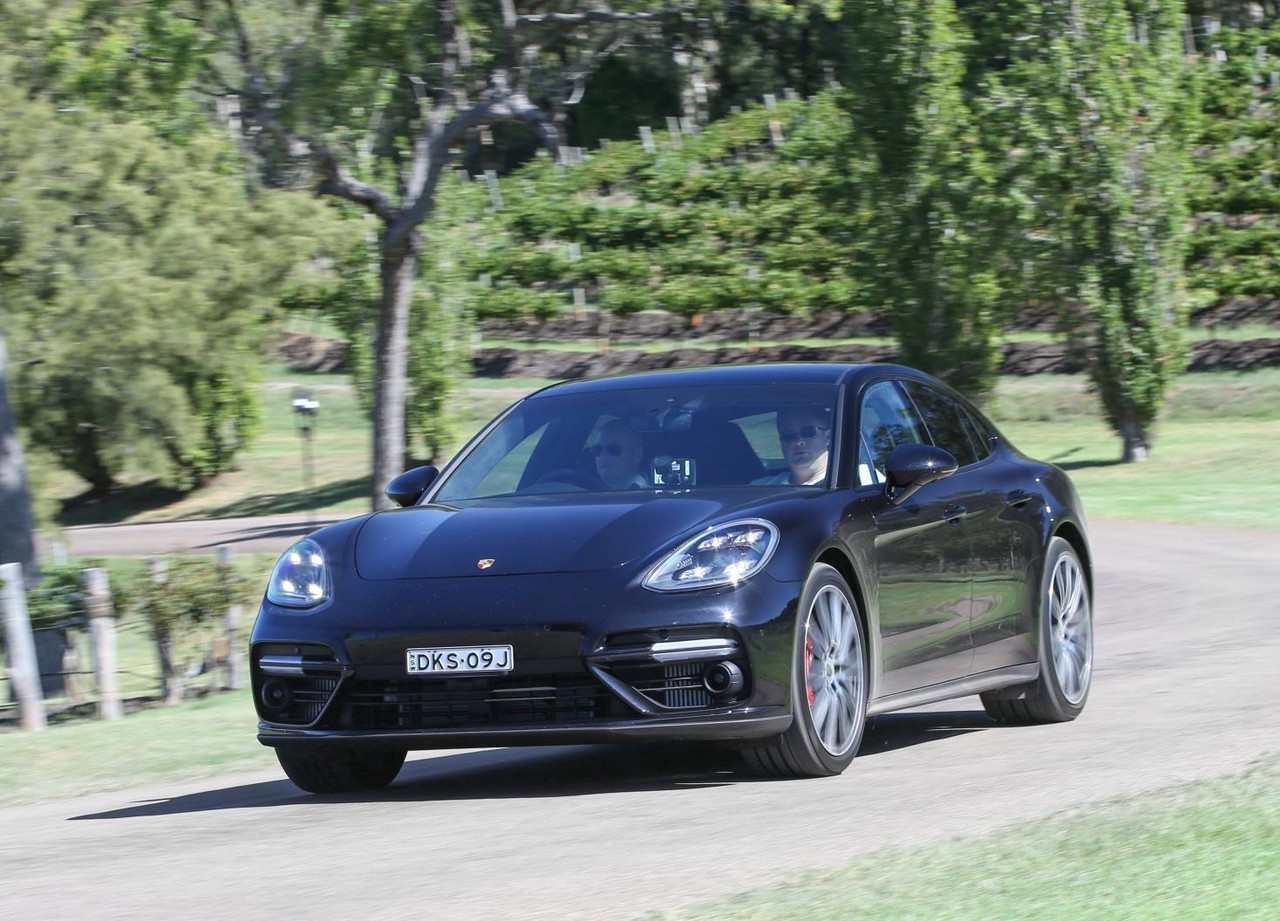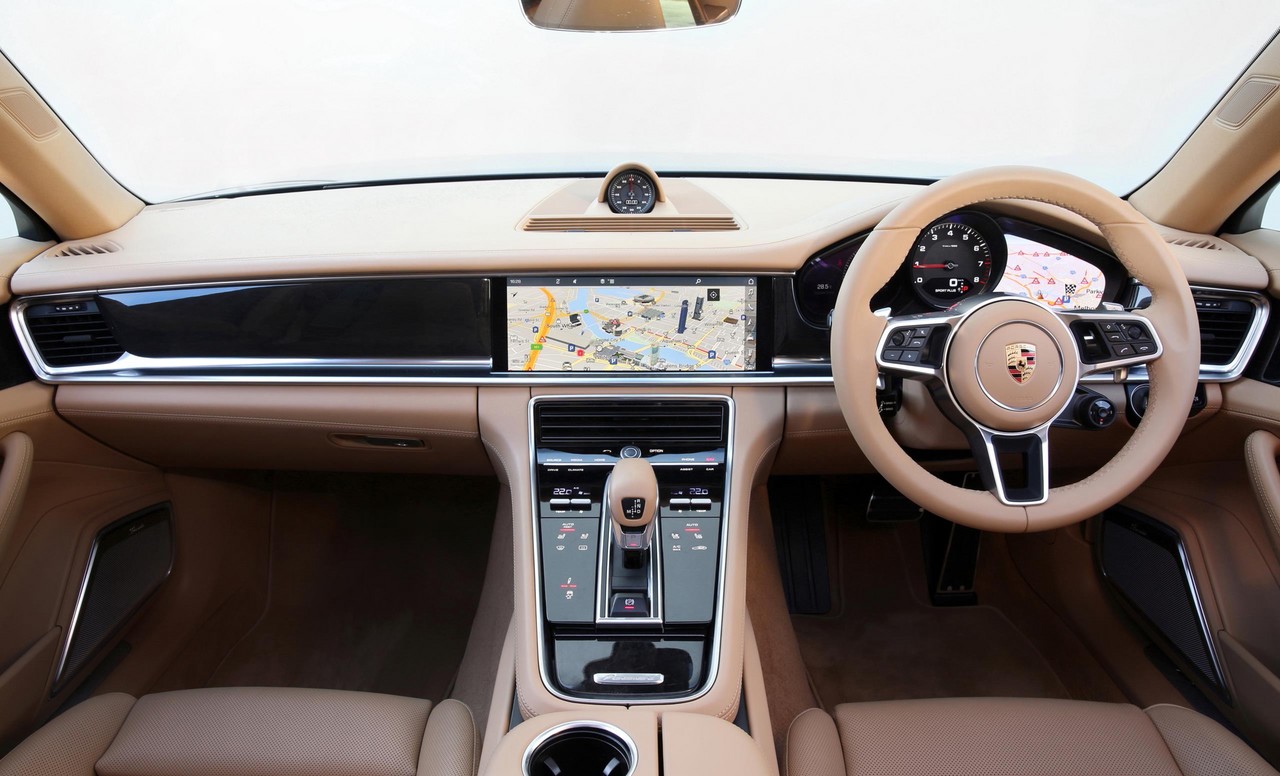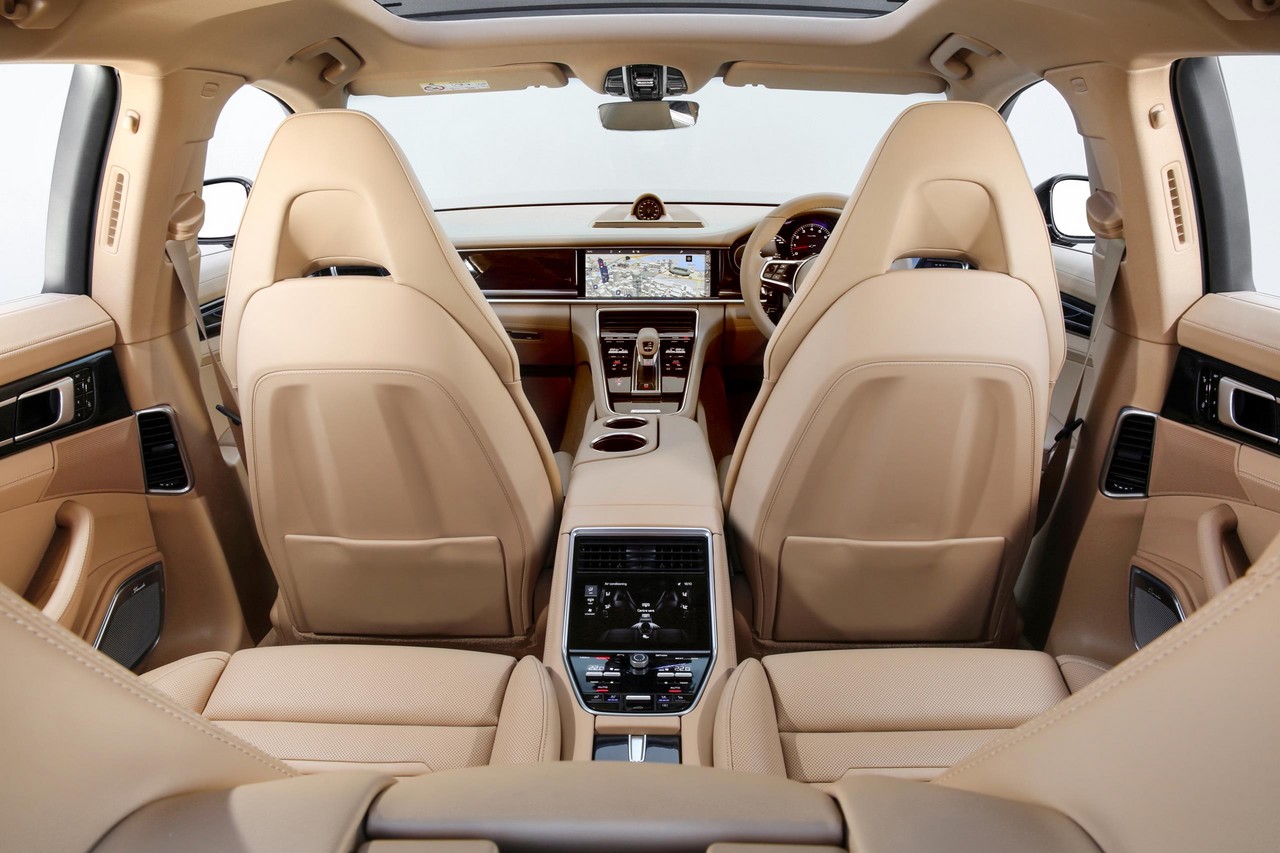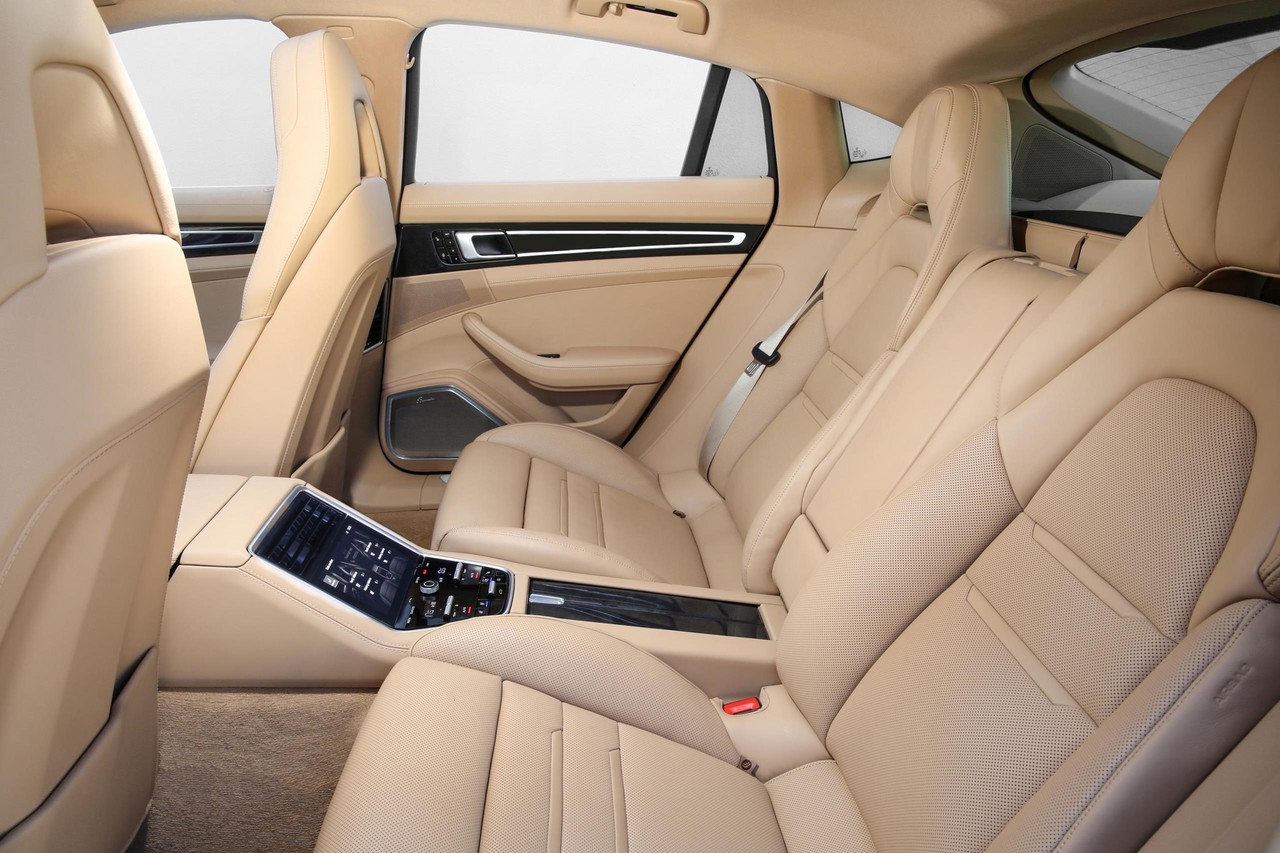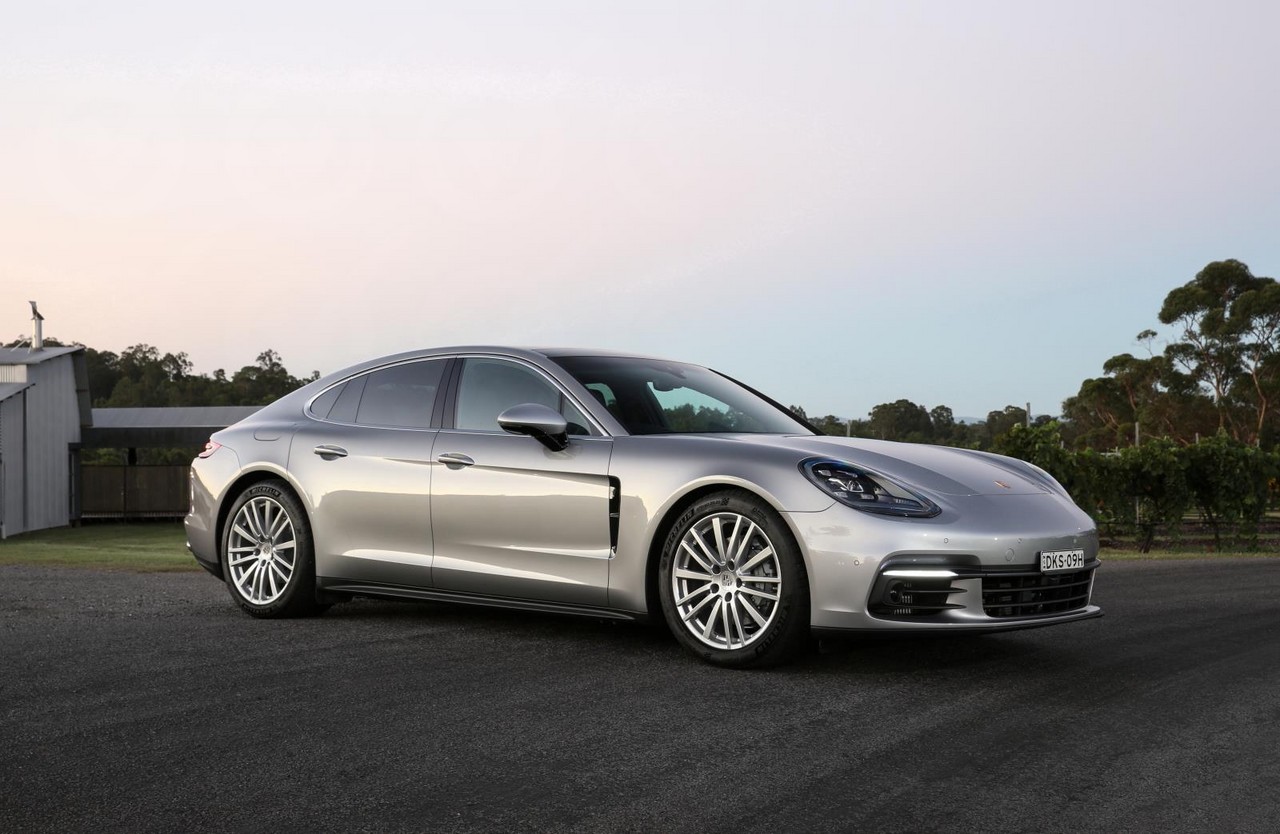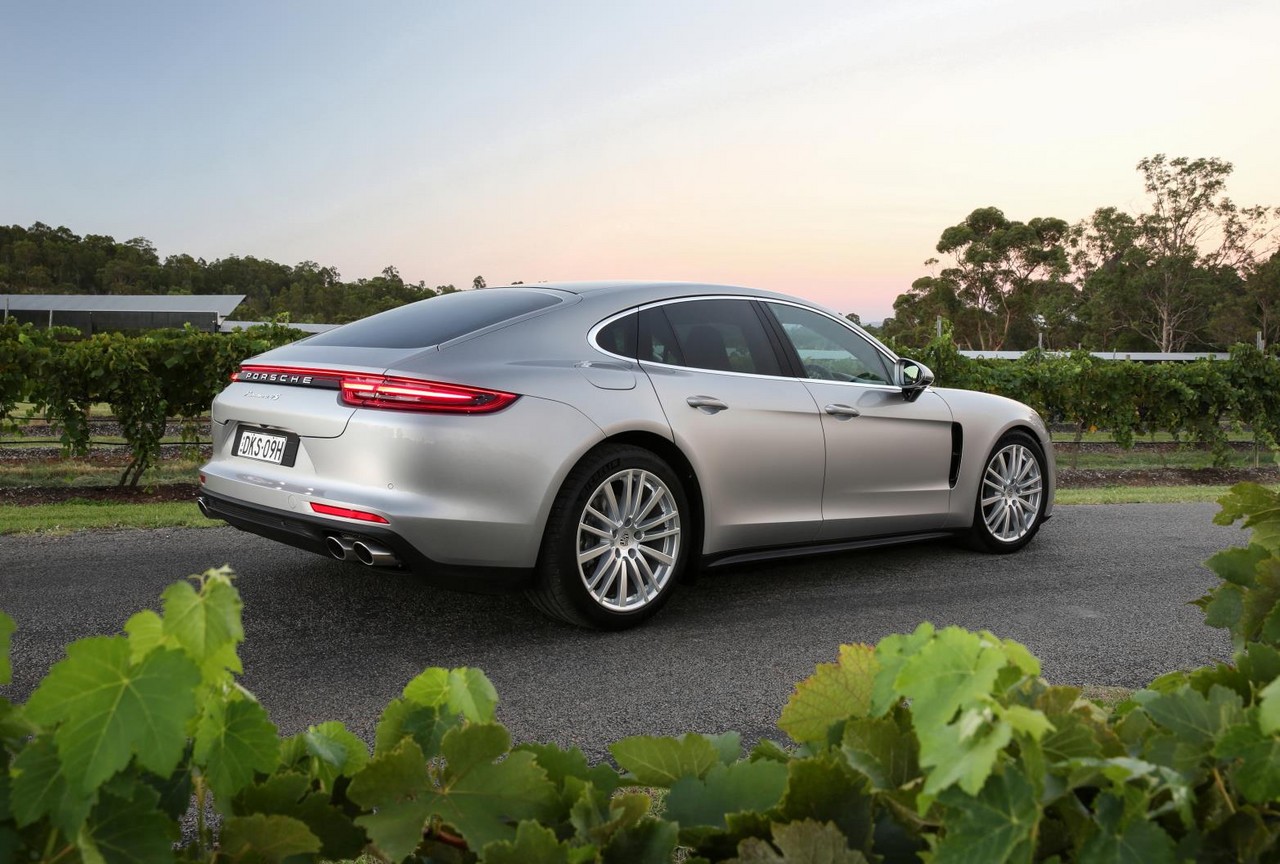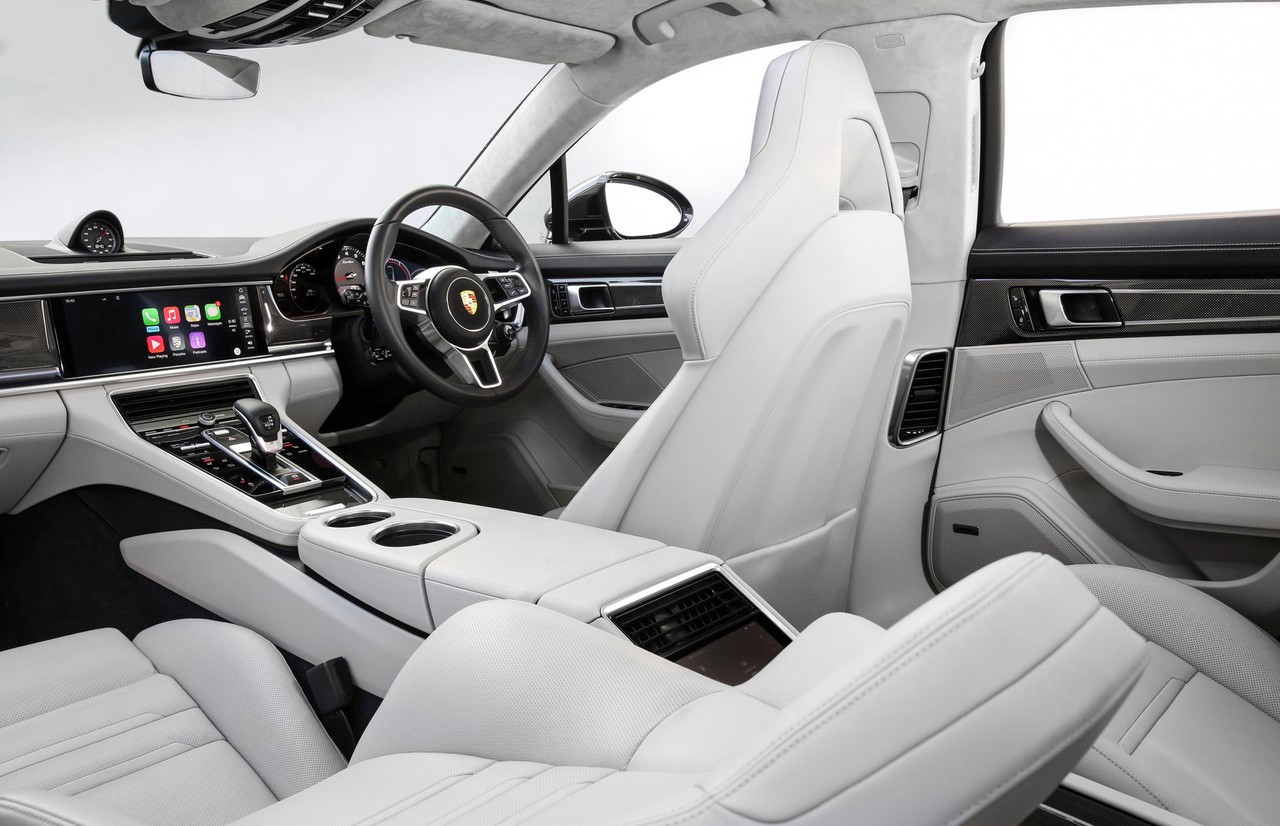
- Powerful turbocharged engines
- Well-weighted steering provides excellent feedback
- Impressive dynamics, while adjustable dampers provide comfortable ride
- All-wheel drive traction makes for excellent dynamics
- High standard of interior fit and finish
- Autonomous emergency braking not available at launch
- Sheer width can make for awkward manoeuvring
- Limited rear seat space for Panamera fastback
Overview
Commencing production in November 2016, the Porsche 971 Panamera was initially as a four-door fastback, with a five-door estate (‘Sport Turismo’) following later in 2017. Manufactured in Leipzig, Germany, the Porsche 971 Panamera range initially consisted of the 4S and Turbo variants, followed by the 4S Diesel, standard Panamera, 4 and 4 E-Hybrid.
As per the table below, the Panamera variants were distinguished by their powertrains. To reduce fuel consumption, however, all engines had:
- An ‘auto start/stop’ function which could shut down the engine when the Panamera was stationary in traffic; and,
- A coasting function which could disengage the engine from the driveline when coasting to prevent engine braking.
For the Panamera Turbo, its V8 engine could shut down four-cylinders under light loads to reduce fuel consumption; for the Panamera 4S Diesel, only one of its variable turbine geometry turbochargers operated below 2700 rpm, with the other operating at engine speeds above this.
| Variant | Engine | Trans. | Peak power | Peak torque |
|---|---|---|---|---|
| Standard, 4 |
2995 cc biturbo petrol V6 | 8sp DCT | 243 kW at 5400-6400 rpm | 450 Nm at 1340-4900 rpm |
| 4S | 2894 cc CSZ biturbo petrol V6 | 8sp DCT | 324 kW at 5650-6600 rpm | 550 Nm at 1750-5500 rpm |
| Turbo | 3996 cc CVD biturbo petrol V8 | 8sp DCT | 404 kW at 5750-6000 rpm | 770 Nm at 1960-4500 rpm |
| 4 E-Hybrid | 2894 cc petrol V6 | 8sp DCT | 243 kW | N/A |
| Electric motor | 100 kW | N/A | ||
| Combined | 340 kW at 6000 rpm | 700 Nm at 1100-4500 rpm | ||
| 4S Diesel | 3956 cc diesel V8 (sequential turbos) | 8sp DCT | 310 kW at 3500-5000 rpm | 850 Nm at 1000-3250 rpm |
971 Panamera: all-wheel drive system
The Porsche Panamera’s four-wheel drive system utilised an electronically controlled multiple-plate clutch – integrated in the gearbox – to distribute torque between the front and rear axles in a fully variable manner. As such, there was no pre-determined torque split, with the Porsche Traction Management (PTM) system continually monitoring driving conditions. For example, if the rear wheels started to spin when accelerating, the multi-plate clutch would intervene to direct more power to the front wheels. When cornering, the delivery of power to the front wheels is also monitored to provide optimum lateral stability. The all-wheel drive system also included an automatic brake differential which, if the drive wheels begin to spin, braked the individual wheel with the higher level of slip.
As an extra-cost option, the 971 Panamera could be specified with ‘Porsche Torque Vectoring Plus’ (PTV Plus) which consisted of an electronically-controlled, fully variable rear differential lock. Integrated into the all-wheel drive management system, PTV Plus would engage the rear differential lock if one of the rear wheels began to spin, thereby directing torque to the opposite rear wheel.
Body and dimensions: Porsche Panamera
The Porsche 971 Panamera was underpinned by Porsche’s MSB platform which featured a hybrid steel/aluminium bodyshell. To reduce mass, aluminium was also used for the Panamera’s bonnet, rear hatch, doors, side sections, roof and front wings. Compared to the Porsche 970 Panamera, the 971 Panamera wais 79 mm longer (at 5049 mm), 6 mm wider (1937 mm), 5 mm taller (1423 mm) and has a 30 mm longer wheelbase (2950 mm). Furthermore, the 971 Panamera had a drag co-efficient of 0.29 Cd and boot capacity of 495 litres.
Body and dimensions: Porsche Panamera Sport Turismo
Compared to the Panamera saloon, the Panamera Sport Turismo had a 5 mm higher roofline (at 1428 mm) and an elongated window line for greater headroom and easier ingress and egress. As standard, the Panamera Sport Turismo had three rear seats in a 2+1 configuration; as an option, however, the Panamera Sport Turismo could be specified in a four-seat configuration with two individual rear seats that had power adjustment. The three rear seat backrests could be folded down together or individually (in a 40:20:40 split) and unlocked electrically from the luggage compartment.
Luggage capacity for the Panamera Sport Turismo was 520 litres, an increase of around 50 litres relative to the Panamera saloon. With all backrests folded down, the Panamera Sport Turismo had a ‘virtually flat’ load floor and cargo volume of 1390 litres.
The Porsche Panamera Sport Turismo had an ‘adaptively extendible roof spoiler’ that operated in three states. At speeds below 170 km/h, the aerodynamic guide element would stay in its retracted position with an angle of minus seven degrees to reduce drag. Above 170 km/h, the roof spoiler would move to the ‘performance position’ with an angle of plus one degree to increase downforce. In the Sport and Sport Plus drive modes, however, the roof spoiler would automatically move to the performance position at speeds of 90 km/h and above. According to Porsche, the roof spoiler could generate additional downforce of up to 50 kg on the rear axle. Furthermore, the roof spoiler’s angle would switch to plus 26 degrees when the panoramic sliding roof was open at speeds of 90 km/h or above to reduce wind noise.
Suspension
The Porsche 971 Panamera has double wishbone front suspension and multi-link rear suspension. The suspension also included:
- Adaptive air springs with three-chamber air technology; and,
- Porsche’s Active Suspension Management Technology (PASM). With continuously adjustable shock absorbers and a pair of accelerometers, PASM offers selectable drive modes which also adjusted engine mapping, steering assistance and transmission behaviour.
As an extra-cost option, the 971 Panamera could also be specified with:
- ‘Porsche Dynamic Chassis Control’ (PDCC) which consisted of active anti-roll bars that responded to steering angle and lateral acceleration to provide a stabilising force that reduced body roll; and,
- Rear axle steering.
Steering
The Porsche 971 Panamera had rack-and-pinion steering with electric power assistance.
Safety equipment
Standard safety equipment for the Porsche 971 Panamera included dual front airbags, dual front knee airbags, front seat-mounted side airbags (Porsche Side Impact Protection System or POSIP), rear side airbags, full-length curtain airbags (i.e. for front and rear occupants), ABS, electronic brake force distribution, brake assist, electronic stability control, traction control and front seatbelts with pre-tensioners and load limiters.
As standard, the Porsche 971 Panamera was fitted with an ‘active bonnet’ which had pyrotechnic actuators in the bonnet hinges. In the event of a pedestrian collision, the actuators deployed and locks kept the bonnet in a raised position to provide additional deformation space between the bonnet and hard structures beneath it.
The Porsche 971 Panamera Turbo was also fitted with:
- Lane Change Assist: used a radar to monitor traffic in adjacent lanes behind the Panamera and warn the driver of approaching traffic by illuminating LEDs in the corresponding door mirror; and,
- Lane Keeping Assist: used a forward-facing camera to monitor the Panamera’s position within its lane. In the event that the Panamera was about to depart from its lane without indicating, corrective steering inputs were applied to return the vehicle to the centre of its lane and the driver was alerted via steering wheel pulsations.
As an extra-cost option, the Porsche 971 Panamera could be specified with Porsche’s ‘night vision assistant’ which used a thermal imaging camera to detect people and large animals, and displays a colour highlighted warning indicator in the cockpit.
Brakes
The Porsche Panamera 4S and 4S Diesel had 360 mm by 36 mm ventilated front brake discs with six-piston aluminium monobloc fixed calipers and 330 mm by 28 mm ventilated rear discs with four-piston aluminium monobloc fixed calipers. The Porsche Panamera Turbo, however, had 410 mm by 38 mm front discs and 380 mm by 30 mm rear discs.
As an extra-cost option, the Panamera could be specified with the Porsche Carbon Ceramic Brake (PCCB) package which included 420 mm by 40 mm front discs and 390 mm by 32 mm rear discs.
Wheels and tyres
The Porsche Panamera, 4, 4S and 4S Diesel had 9.0J x 19-inch front alloy wheels with 265/45 ZR19 tyres and 10.5J x 19-inch rear alloy wheels with 295/40 ZR19 tyres. The Porsche Panamera Turbo, however, had 9.5J x 20-inch front alloy wheels with 275/40 ZR20 tyres and 11.5J x 20-inch rear alloy wheels with 315/35 ZR20 tyres.
As standard, the Porsche Panamera was fitted with a tyre repair kit rather than a spare wheel.
Features: Panamera and Panamera 4
Standard features for the Porsche 971 Panamera and Panamera included the Porsche Communication Management (PCM 4.1) system with a 12.3-inch touchscreen, satellite navigation, Bluetooth mobile phone connectivity, voice control and Apple Car Play smartphone integration. Beyond this, the audio system consisted of a 710 watt Bose surround sound system with fourteen speakers and subwoofer, digital radio (DAB) tuner, 3.5 mm auxiliary and USB input.
The Panamera and Panamera 4 were also fitted with 19-inch alloy wheels with 265/45 R19 front and 295/40 R19 rear tyres, four-zone climate control air conditioning, partial leather seats, fourteen-way power adjustable front seats, ventilated and heated front seats, LED headlights with Porsche Dynamic Light System (PDLS), LED daytime running lights, dusk-sensing headlights, rain-sensing wipers, front and rear parking sensors (Porsche’s ‘ParkAssist’), 40:20:40 folding rear seats, a leather-wrapped steering wheel with gearshift paddles, remote central locking with proximity key, power adjustable and heated door mirrors with power folding function, power windows, a power adjustable steering wheel (for height and reach), memory settings (for the front seats, steering column and door mirrors), auto-dimming mirrors, push-button start, electric parking brake, a 12 volt power socket, soft-close doors, illuminated vanity mirrors, a power-operated rear hatch, rear privacy glass, a panoramic glass sunroof, brushed aluminium door sills, tyre pressure monitoring, a trip computer, an alarm and immobiliser.
As standard, the Porsche 971 Panamera was equipped with Adaptive Cruise Control (ACC) which can maintain a pre-set speed and automatically apply the brakes or accelerator to maintain a pre-determined distance from the vehicle ahead.
The 971 Panamera was also equipped with Porsche’s Surround View, a surround view camera system which can provide a bird’s eye graphical representation of the vehicle on the central display screen and show the proximity of nearby obstacles.
Features: Panamera 4S and 4S Diesel
Compared to the Panamera 4 and 4S, the Porsche Panamera 4S and 4S Diesel were further equipped with soft-close doors and an automatically-deploying rear spoiler.
Features: Panamera Turbo
Relative to the Panamera 4S and 4S Diesel, the Panamera Turbo was further equipped with Alcantara interior trim and the Porsche Dynamic Light System Plus (PDLS Plus) in which the LED matrix headlights had 84 image individual diodes that could be turned off or selectively dimmed to avoid dazzling the car ahead or oncoming traffic.
